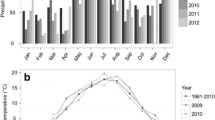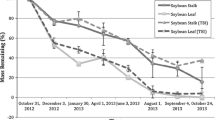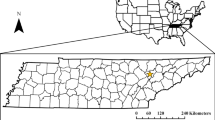Abstract
Trees are intentionally integrated in agroforestry for numerous ecosystem services including carbon sequestration, environmental, production, and economics. Open tree growth is different from that in forests and data is limited, thus restricting integration of trees in agroforestry for optimum benefits. Growth of pin oak (Quercus palustris Muenchh.), swamp white oak (Q. bicolor Willd.), and bur oak (Q. macrocarpa Michx.) were evaluated for 24 years in an alley cropping agroforestry watershed in Northern Missouri, USA. Containerized oak seedlings were planted at 3-m spacing in the center of 4.5-m wide contour grass-legume strips established at 22.8–36.5 m intervals on a 4.44-ha watershed with a corn (Zea mays L.)-soybean (Glycine max (L.) Merr.) rotation. Tree height and diameter (dbh and 10-cm) were recorded. Among the three species pin oak had the greatest height, diameter at 10-cm, and dbh growth during the 24-year study. Pin oak trees showed 1.2-, 1.4-, and 1.2-times greater height, 10-cm diameter, and dbh than swamp white oak trees, the second-best species at the watershed. Biomass and carbon values of pin oak were 1.7 and 3.7 times in 2021 than swamp white oak and bur oak. Bur oak trees had the lowest height, 10-cm diameter, dbh, biomass, and carbon values among the three species. With the 3-species composition, tree biomass and carbon accumulation in a 24-year period were 22,613 and 10,854 kg ha−1. Trees had > 20% tapering in the main stem. Among the three species swamp white oak had 21% tapering while pin and bur oak both had 25% tapering. All three species appear to be suitable for watershed protection while pin oak showed promising growth and greater accumulation of biomass and carbon. The study emphasizes development of agroforestry-specific tree growth models as open-grown trees differ from those in conventional forestry. This can help the selection of suitable species for enhanced ecosystem services.


(Source: Missouri Mesonet/University of Missouri)






Similar content being viewed by others
References
Alagele SM, Anderson SH, Udawatta RP (2020) Agroforestry, grass, biofuel crop, and row-crop management effects on soil water dynamics for claypan landscapes. Soil Sci Soc Am J 84:203–219. https://doi.org/10.1002/saj2.20026
Alagele SM, Jose S, Anderson SH, Udawatta RP (2021) Hydraulic lift: processes, methods, and practical implications for society. Agroforest Syst 95:641–657. https://doi.org/10.1007/s10457-021-00614-w
Beer J, Muschler R, Kass D, Somarriba E (1998) Shade management in coffee and cacao plantations. Agroforest Syst 38:139–164
Benjamin AR, Gingrich SF (1968) Even-aged silviculture for upland central hardwoods. Agriculture Handbook, vol 355. Forest Service USDA, Washington
Bentrup G, Hopwood J, Adamson NL, Powers R, Vaughan M (2021) The role of temperate agroforestry practices in supporting pollinators. In: Udawatta RP, Jose S (eds) Ecosystem services of agroforestry. Springer, The Netherlands, pp 275–304
Brandle JR, Hodges L, Tyndall J, Sudmeyer RA (2009) Windbreak practices. In: Garrett HE (ed) North American agroforestry: an integrated science and practice, 2nd edn. Am Soc Agronomy Madison, USA, pp 75–104
Brienen RJW, Zuidema PA (2005) Relating tree growth to rainfall in Bolivian rain forests: a test for six species using tree ring analysis. Oecologia 146:1–12. https://doi.org/10.1007/s00442-005-0160-y
Buck LE, Lassoie JP, Fernandes ECM (1999) Agroforestry in sustainable agricultural systems. CRC Press LLC, Boca Raton, p 416
Buresh RJ, Rowe EC, Livesley SJ, Cadisch G, Mafongoya P (2004) Opportunities for capture of deep soil nutrients. In: van Noordwijk M, Cadisch G, Ong CK (eds) Below-ground interactions in tropical agroecosystems. CABI, UK, pp 109–125
Burwell RE, Schuman GE, Saxton KE, Heinemann HG (1976) Nitrogen in subsurface discharge from agricultural watersheds. J Environ Qual 5:325–329
Cadisch G, Willigen P, de Suprayogo D, Mobbs DC, van Noordwijk M, Rowe EC (2004) Catching and competing for mobile nutrients in soils. In: van Noordwijk M, Cadisch G, Ong CK (eds) Below-ground interactions in tropical agroecosystems. CABI, UK, pp 171–191
Cai Z, Aguilar FX (2021) Economic evaluation of agroforestry ecosystem services. In: Udawatta RP, Jose S (eds) Ecosystem services of agroforestry. Springer, The Netherlands, pp 477–494
Chausson A, Turner B, Seddon D, Chabaneix N, Girardin CAJ, Kapos V, Key I, Roe D, Smith A, Woroniecki, Seddon N (2020) Mapping the effectiveness of nature-based solutions for climate change adaptation. Global Chang Biol 26:6134–6155
Chojnacky DC, Heath LS, Jenkins JC (2013) Updated generalized biomass equations for North American tree species. Forestry. https://doi.org/10.1093/forestry/cpt053
Dey DC, Kabrick JM, Gold MA (2003) Tree establishment in floodplain agroforestry practices. In: Sharrow P (ed.) 8th North American agroforestry conference; June 2003. School of Forestry, Oregon State University, Corvallis, OR. pp. 102-115
Dupraz C, Simorte V, Dauzat M, Bertoni G, Bernadac A, Masson P (1999) Growth and nitrogen status of young walnuts as affected by intercropped legumes in a Mediterranean climate. Agroforest Syst 43:71–80
Freedman B, Dunker P, Barclay H, Morash R, Prager U (1982) Forest biomass and nutrient studies in central Nova Scotia Maritimes Forest Research Center. Can For Serv Dept of Environ Inf. Rep. M-X-134
Garrett HE, McGraw RL, Walter WD (2009) Alley cropping practices. In: Garrett HE (ed.) North American agroforestry: an integrated science and practice, 2nd Edition. Am Soc Agronomy, Madison, USA, pp 133–162
Garrett HE (2009) North American agroforestry: an integrated science and practice, 2nd Edition. Am. Soc. Agronomy. Madison, USA p. 379
Getnet D, Mekonnen Z, Anjulo A (2023) The potential of traditional agroforestry practices as nature-based carbon sinks in Ethiopia. Nat-Based Solut 4:100079. https://doi.org/10.1016/j.nbsj.2023.100079
Grossman BC, Gold MA, Dey DC (2003) Restoration of hard mast species for wildlife in Missouri using precocious flowering oak in the Missouri River floodplain, USA. Agroforest Syst 59:3–10
Haines HA, Olley JM (2017) The implications of regional variations in rainfall for reconstructing rainfall patterns using tree rings. Hydrol Process 31:1951–1960. https://doi.org/10.1002/hyp.11238
Huber H, Hutchings MJ (1997) Differential response to shading in orthotropic and plagiotropic shoots of the clonal herb Glechoma hirsuta. Oecologia 112(4):485–491. https://doi.org/10.1007/s004420050336
Jenkins JC, Chojnacky DC, Heath LS, Birdsey RA (2003) National-scale biomass estimators for United States tree species. For Sci 49:12–35
Johnson PS, Shifley SR, Rogers R (2002) The ecology and silviculture of oaks. CABI Publishing, New York, p 503
Jose S (2009) Agroforestry for ecosystem services and environmental benefits: an overview. Agroforest Syst 76:1–10. https://doi.org/10.1007/s10457-009-9229-7
Jose S, Gillespie AR, Seifert JR, Mengel DB, Pope PE (2000) Defining competition vectors in a temperate alley cropping system in the Midwestern USA 3. Competition for nitrogen and litter decomposition dynamics. Agroforest Syst 48:61–77
Khabou W (2002) The effect of orthotropic and plagiotropic shoots on semi-hard wood cuttings rhizogenesis of some Tunisian olive cultivars. Acta Hortic 586:887–890. https://doi.org/10.17660/ActaHortic.2002.586.193
Kumar M, Singh H (2020) Agroforestry as a nature-based solution for reducing community dependence on forests to safeguard forests in rainfed areas of India. In: Dhyani S, Gupta A, Karki M (eds) Nature-based solutions for resilient ecosystems and societies. Disaster Resilience and Green Growth. Springer, Singapore. https://doi.org/10.1007/978-981-15-4712-6_17
Lamlom SH, Savidge RA (2003) A reassessment of carbon content in wood: variation within and between 41 North American Species. Biomass Bioenerg 25:381–388
Littlefield CE, D’Amato AW (2022) Identifying trade-offs and opportunities for forest carbon and wildlife using a climate change adaptation lens. Conserv Sci Pract 4(4):e12631
Montagnini F, Nair PKR (2004) Carbon sequestration: an underexploited environmental benefit of agroforestry systems. Agroforest Syst 61:281–295
Muth D (2014) Profitability versus environmental performance: are they competing? J Soil Water Conserv 69(6):203A-206A. https://doi.org/10.2489/jswc.69.6.203A
Nair PKR, Nair VD (2003) Carbon storage in North American agroforestry systems. In: Kimble JM et al (eds) The potential of U.S. forest soils to sequester carbon and mitigate the greenhouse effect. CRC Press, Boca Raton, pp 333–346
NCEI: https://www.ncei.noaa.gov/ Accessed 10 Sept 2022
Nissen TM, Midmore DJ (2002) Stand basal area as an index of tree competition in timber intercropping. Agroforest Syst 54:51–60
Owenby JR, Ezell DS (1992) Monthly station normals of temperature, precipitation, and heating and cooling degree days 1961–90. Climatography of the United States No. 81. National Climatic Data Center, Ashville, NC
Rabalais NN, Turner RE (2019) Gulf of Mexico hypoxia: past, present, and future. Bulletin 28:117–124
Sahin H, Anderson SH, Udawatta RP (2016) Water infiltration and soil water content in claypan soils influenced by agroforestry and grass buffers compared to row crop management. Agroforest Syst. https://doi.org/10.1007/s10457-016-9899-x
Salceda MG, Udawatta RP, Nelson KA, Mendis SS, Bardhan S (2022) Spatial and temporal variability of soil organic carbon on a corn–soybean watershed with 23 years of agroforestry. Agron J 114:440–451. https://doi.org/10.1002/agj2.20948
Schaller M, Schroth G, Beer J, Jiménez F (2002) Species and site characteristics that permit association of fast-growing trees with crops: the case of Eucalyptus deglupta as coffee shade in Costa Rica. For Ecol Manag 175:205–215
Schroth G, Lehmann J, Rodrigues MRL, Barros E, Macedo JLV (2001) Plant-soil interactions in multistrata agroforestry in the humid tropics. Agroforest Syst 53:85–102
Schultz, RC, Udawatta RP, Isenhart TM, Simpkins WW (2022) Riparian and upland buffer practices. In: Garrett HE, Jose S, Gold M (eds.) North American agroforestry: an integrated science and practice, 3rd Edition. American Society of Agronomy-Crop Science Society of America-Soil Science Society of America (ASA-CSSA-SSSA). Madison, WI, USA, pp 197–271
Seiter S, William RD, Hibbs DE (1999) Crop yield and tree-leaf production in three planting patterns of temperate-zone alley cropping in Oregon, USA. Agroforest Syst 46:273–288
Senaviratne GMMMA, Udawatta RP, Nelson KA, Shannon K, Jose S (2012) Temporal and spatial influence of perennial upland buffers on corn and soybean yields. Agron J 104:1356–1362. https://doi.org/10.2134/agronj2012.0081
Senaviratne GMMMA, Udawatta RP, Baffaut C, Anderson SH (2013) Agricultural policy environmental extender simulation of three adjacent row-crop watersheds in the claypan region. J Environ Qual 42:726–736. https://doi.org/10.2134/jeq2012.0241
Senaviratne GMMMA, Udawatta RP, Anderson SH, Baffaut C, Thompson A (2014) Use of Fuzzy rainfall-runoff predictions for claypan watersheds with conservation buffers. J Hydrol 507:1008–1018. https://doi.org/10.1016/j.jhydrol.2014.06.023
Sharrow SH, Brauer D, Clason TR (2009) Silvopastural practices. In: Garrett HE (ed) North American agroforestry: an integrated science and practice, 2nd edn. Am Soc Agron Madison, USA, pp 105–131
Smith MM, Bentrup G, Kellerman T, MacFarland K, Straight R, Ameyaw L (2022) Agroforestry extent in the United States: a review of national datasets and inventory efforts. Agriculture 12(5):726. https://doi.org/10.3390/agriculture12050726
Udawatta RP, Gantzer CJ (2022) Soil and water ecosystem services of agroforestry. J Soil Water Conserv 77(1):5A-11A. https://doi.org/10.2489/jswc.2022.1028A
Udawatta RP, Krstansky JJ, Henderson GS, Garrett HE (2002) Agroforestry practices, runoff, and nutrient loss: a paired watershed comparison. J Environ Qual 31:1214–1225
Udawatta RP, Nygren PO, Garrett HE (2005) Growth of three oak species during establishment of an agroforestry practice for watershed protection. Can J Res 35:603–609
Udawatta RP, Garrett HE, Kallenbach RL (2011a) Agroforestry buffers for nonpoint source pollution reductions from agricultural watersheds. J Environ Qual 40:800–806. https://doi.org/10.2134/jeq2010.0168
Udawatta RP, Anderson SH, Motavalli PP, Garrett HE (2011b) Calibration of a water content reflectometer and soil water dynamics for an agroforestry practice. Agroforest Syst 82:61–75. https://doi.org/10.1007/s10457-010-9362-3
Udawatta RP, Motavalli PP, Jose S, Nelson KA (2014) Temporal and spatial differences in crop yields of a mature silver maple alleycropping system. Agron J 106(2):407–415. https://doi.org/10.2134/agronj2013.0429
Udawatta RP, Gantzer CJ, Reinbott TM, Wright RL (2016) Yield differences influenced by distance from riparian buffers and conservation reserve program. Agron J 108(2):647–655. https://doi.org/10.2134/agronj2015.0273
Udawatta RP, Gantzer CJ, Jose S (2017) Agroforestry practices and soil ecosystem services. In: Al-Kaisi MM, Lowery B (eds) Soil health and intensification of agroecosytems. Elsevier, USA, pp 305–334
Udawatta RP, Rankoth LM, Jose S (2021) Agroforestry for biodiversity conservation and improvement. In: Udawatta RP, Jose S (eds) Ecosystem services of agroforestry. Springer, The Netherlands, pp 245–274
Unklesbay AG, Vineyard JD (1992) Missouri geology. University of Missouri Press, Columbia, p 189
USDA-NRCS (2013) Assessment of the effects of conservation practices on cultivated cropland in the Lower Mississippi River Basin, p 201
van Noordwijk M, Lawson G, Soumaré A, Groot FFR, Hairiah K (1996) Root distribution of trees and crops: competition and/or complementarity. In: Ong CK, Huxley P (eds) Tree-crop interactions: a physiological approach. CAB International, Wallingford, pp 319–364
Watson FC (1979) Soil Survey of Knox, Monroe, and Shelby Counties, Missouri. USDA, Soil Conser. Service, Missouri Agric. Expt. Stn. U.S. Govt. Print. Office. Washington, DC
Zhou XH, Brandle JR, Tala A, Awada TN, Schoeneberger MM, Martin DL, Xin Y, Tang ZH (2011) The use of forest-derived specific gravity for the conversion of volume to biomass for open-grown trees on agricultural land. Biomass Bioenerg 35(5):1721–1731
Zhou XH, Schoeneberger MM, Brandle JR, Awada TN, Chu J, Martin DL, Li J, Li Y, Mize CW (2015) Analyzing the uncertainties in use of forest-derived biomass equations for open-grown trees in agricultural land. For Sci 61(1):144–161. https://doi.org/10.5849/forsci.13-071
Acknowledgements
This work was supported by the University of Missouri Center for Agroforestry and the USDA-ARS Dale Bumpers Small Farms Research Center, Agreement Number 58-6020-0-007 Agricultural Research Service.
Author information
Authors and Affiliations
Contributions
RPU: Data collection, Wrote the manuscript, edited, prepared figures SSM: Data collection, statistical analysis, prepared figures MS: Data collection, reviewed the manuscript LR: Data collection, reviewed the manuscript CW: Data collection,reviewed the manuscript
Corresponding author
Ethics declarations
Conflict of interest
The authors declare no competing interests.
Additional information
Publisher's Note
Springer Nature remains neutral with regard to jurisdictional claims in published maps and institutional affiliations.
Rights and permissions
Springer Nature or its licensor (e.g. a society or other partner) holds exclusive rights to this article under a publishing agreement with the author(s) or other rightsholder(s); author self-archiving of the accepted manuscript version of this article is solely governed by the terms of such publishing agreement and applicable law.
About this article
Cite this article
Udawatta, R.P., Mendis, S.S., Salceda, M. et al. Open growth of oak species in a corn/soybean alley cropping agroforestry for watershed protection. Agroforest Syst 98, 653–663 (2024). https://doi.org/10.1007/s10457-023-00937-w
Received:
Accepted:
Published:
Issue Date:
DOI: https://doi.org/10.1007/s10457-023-00937-w




